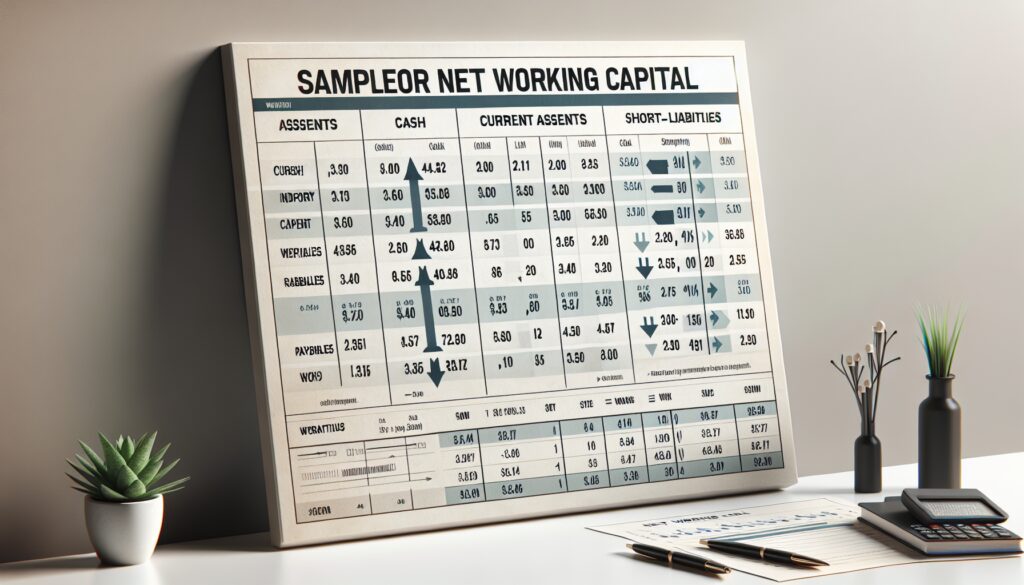Understanding Your Net Working Capital Needs
Start-ups and fast-growing companies have unique working capital demands
The working capital formula helps determine a company’s liquidity. By subtracting current liabilities from current assets, you can gauge if a business can meet short-term obligations. This article will guide you through the working capital formula, detailing each component and offering tips for better financial management.
Fast-growing startup companies have unique cash flow needs, and it is critical to calculate working capital to the penny with a fudge factor. The quick ratio or acid-test ratio is a better gauge of these types of young companies’ liquidity needs. Invoice factoring can help raise cash quickly with weekly cash advances that match your payroll.
Please read our article on how much working capital do I need?
Key Takeaways
- Working capital, calculated by subtracting current liabilities from current assets, is critical for a business’s short-term financial health. It is essential for funding operations and managing cash flow.
- A positive working capital indicates the ability to cover short-term obligations and invest in growth, while negative working capital suggests potential liquidity issues that may hinder financial stability.
- Effective working capital management involves strategic planning, such as accelerating accounts receivable and optimizing operating costs, to improve liquidity and ensure sufficient resources for ongoing operations.
Understanding Working Capital

It serves as the vital fluid of any business, signifying the available resources necessary to satisfy short-term liabilities and drive everyday business activities. This key financial metric calculates current assets by subtracting current liabilities. The significance of this measure lies in its capacity to support operational funding needs, streamline cash flow management, and enable investment opportunities for growth.
Imagine managing an enterprise equipped with the capability to seize market prospects while swiftly navigating fiscal hurdles. Possessing sufficient working capital bestows such a benefit. As a result, it demonstrates a firm’s ability to manage its short-term economic vitality, ensuring that it can cover routine expenses without debt.
Beyond mere numerical analysis, adept management of working capital constitutes strategic foresight. Regular oversight of working capital positions organizations well when facing unforeseen monetary strains or shifts in seasonal demand patterns—it acts as a safeguard during times of financial unpredictability. Disregarding critical signals within working capital evaluations could precipitate pressing liquidity crises. Maintaining alertness in this domain is imperative for sustainable operation.
The Working Capital Formula

The working capital ratio measures a company’s ability to meet short-term obligations by subtracting Current Liabilities from Current Assets. This calculation highlights the available funds for settling immediate debts and expenses.
To compute how much working capital you have, subtract your current liabilities from your current assets. As a result, the outcome clarifies the liquid assets after addressing all liabilities, providing insight into the organization’s cash flow status. Moreover, a company possessing positive working capital is in good standing with adequate resources to manage its short-term financial responsibilities.
Employing this fundamental formula goes beyond crunching numbers. It is a barometer for assessing overall fiscal robustness and operational effectiveness within any business setting. By tracking their working capital levels through regular calculations, companies equip themselves with essential data for strategic planning while ensuring they hold enough liquidity to support continuous operations without interruptions.
Breaking Down Current Assets
Net working capital is derived from the sum of a company’s current assets, which are expected to be liquidated into cash within one year. These include fixed assets, cash and equivalents, marketable securities, accounts receivable—funds owed by clients—inventory stocks ready for sale, and prepaid expenses.
Cash and its equivalents are the most readily available resources for fulfilling immediate obligations related to short-term liabilities. Alongside this immediacy in liquidity are accounts receivable and inventories, which comprise significant portions of a firm’s short-term assets. Marketable securities also contribute to this pool since they quickly convert into cash.
Companies must maintain an acute awareness of their current assets because these elements are vital in ensuring financial fluidity against looming short-term debts. Adept governance over such liquid assets affirms that an enterprise has at hand means for settling imminent fiscal dues and resources primed for seizing growth prospects when they arise.
Identifying Current Liabilities
Current liabilities on your balance sheet are financial obligations that a business needs to pay off within one year, such as:
- accounts payable
- salaries
- taxes due
- short-term loans
Understanding these obligations is vital when computing net working capital and evaluating a company’s ability to meet its short-term financial requirements.
Accounts payable, which represent debts owed for purchases made on credit, and accrued expenses—costs incurred for services or goods received but not yet paid—are typical examples of current liabilities. Also included in this category are tax-related debts arising from unpaid taxes that affect the firm’s liquidity.
Short-term borrowing encompasses any debt scheduled for repayment within 12 months and is counted among current liabilities. Tracking these commitments is crucial so companies can hold adequate liquid assets to satisfy their immediate monetary duties, thus preserving a stable level of working capital.
Calculating Net Working Capital (NWC)
Net Working Capital (NWC) is determined by deducting current liabilities from current assets, offering a key indicator of a company’s liquidity status. The calculation gives insight into the company’s operational effectiveness and capacity to fulfill short-term financial responsibilities, deliberately leaving out non-operating assets such as cash and debt-related obligations. It’s crucial to grasp this dynamic via the net working capital formula.
The significance of NWC lies in its utility for financial analysis. It is important in evaluating potential liquidity challenges and ensuring long-standing fiscal soundness. Consistent evaluations of net working capital enable firms to gauge their readiness to cover imminent expenses and guide strategic choices regarding resource management and investment prospects.
To figure out NWC, one may employ various approaches, including the straightforward subtraction of current liabilities from current assets or alternative calculations like combining Accounts Receivable plus Inventory minus Accounts Payable. Each technique sheds light on facets of a company’s fiscal standing, which assists companies in devising measures that enhance liquidity positions and overall operational productivity.
Practical Example of Working Capital Calculation

Let’s apply the working capital formula to a straightforward scenario. Consider that a company holds current assets amounting to $120,000 and is faced with $70,000 in current liabilities. Calculating Current Assets minus Current Liabilities translates into $120,000 – $70,000 = $50,000.
This computation reveals that the firm has a positive working capital total of $50,000 for imminent financial requirements. Such an ample sum signifies robust liquidity health for the organization—it is well-equipped to settle short-term dues and has room to pursue growth opportunities.
Conducting these assessments routinely gives enterprises insight into their fiscal stability while verifying that they possess sufficient resources to sustain regular operations and accommodate prospective development plans.
Interpreting the Working Capital Ratio
The working capital ratio, derived by dividing current assets by current liabilities, offers an understanding of a company’s capacity to meet its short-term obligations. It demonstrates the number of times a company can pay off its short-term liabilities with its assets that are readily convertible into cash.
A healthy range for this ratio is typically between 1.2 and 2, suggesting that the firm has both stability in its financial state and adequate liquidity to deal with immediate debts. On the other hand, if the ratio falls below one, it could signal potential risks related to liquidity problems and cast doubt on whether the business can fulfill its monetary commitments.
Regularly tracking this metric allows companies to promptly detect precursors of fiscal strain and enact strategies to bolster their liquid resources. By maintaining an optimal working capital ratio, businesses ensure they have enough cushion against financial predicaments while maintaining their agility in capitalizing on expansion opportunities.
Positive vs. Negative Working Capital

When a company has a surplus of current assets over current liabilities, it possesses positive working capital. This financial state is beneficial as it ensures the business can comfortably manage its short-term obligations while also having the capacity to invest in its growth ambitions. Being in such a robust position enables organizations to absorb unforeseen costs and seize new ventures without taking on additional debt.
In contrast, negative working capital arises when an organization’s current liabilities overshadow its current assets, which raises red flags about the firm’s capacity to fulfill immediate debts. Although certain businesses, like grocery chains, may function efficiently with negative working capital due to their rapid cash flow turnover, sustaining this condition for an extended time frame might precipitate liquidity issues and create economic strain for the entity.
It’s crucial for companies facing negative working capital scenarios or those contemplating such financial strategies to carefully evaluate their specific business models against prevailing market trends before committing. They should consider securing alternative funding solutions like invoice factoring or establishing lines of credit that could offer relief by enhancing cash flow and shoring up short-term liquidity challenges.
Improving Your Working Capital

Enhancing working capital entails a range of tactics designed to improve liquidity and a business’s overall financial strength. For example, by speeding up the collection of accounts receivable through early payment incentives or modernizing billing systems, cash flow can be significantly improved. Similarly, refining how accounts payable are handled by securing more favorable payment conditions and utilizing digital payments can lead to better control over financial outflows.
Selling terms can significantly affect your cash flow. Please read our article on net 30, 60, and 90-day selling terms.
Minimizing operational expenses via process optimization or renegotiating existing contracts—while maintaining service quality—can also release vital funds. A thorough comprehension of the working capital cycle, which encompasses inventory, receivable, and payable days, is essential for proficient cash flow management.
By adopting these measures strategically, companies ensure they maintain adequate working capital to support day-to-day operations and nurture prospects for expansion. A young company must generate cash every day.
Quick Ratio or Acid-Test Ratio
The quick ratio, or acid-test ratio, measures a company’s ability to meet its short-term liabilities without relying on inventory sales. It is calculated by dividing liquid assets—cash, cash equivalents, and accounts receivable—by current liabilities. It measures a company’s liquid assets or liquidity.
Your quick ratio provides a clear picture of a company’s short-term financial health. A quick ratio of 1 or higher indicates that a company can cover its short-term bills or financial obligations.
The Quick ratio is critical to B2B businesses with a relentless weekly payroll, like staffing agencies, security guard companies, and janitorial services.
Common Pitfalls in Working Capital Management
Navigating the complexities of managing working capital can be fraught with difficulties. For instance, a notable challenge is the potential strain on supplier relationships caused by delayed payments, which might result in less advantageous credit terms. Therefore, companies should manage their cash flow well and maintain positive relations with suppliers.
Overlooking short-term liabilities often leads to a sudden reduction in working capital, exposing companies to liquidity crises. To mitigate this risk, businesses should consistently review and refresh their financial statements.
Neglecting to request advance payments when handling large orders may exert extra pressure on a company’s working capital and hinder the completion of these orders. Forward-thinking planning and arranging appropriate funding are crucial steps in ensuring that sufficient working capital is available for meeting current commitments and embracing new business opportunities.
Summary
Understanding the working capital formula and handling your business’s liquidity is essential for fostering financial stability and expansion. Grasping what constitutes working capital, determining net working capital, and analyzing the working capital ratio empower enterprises to make knowledgeable choices that bolster their fiscal wellness.
It’s important to note that having adequate working capital involves more than mere numerical considerations. It requires thoughtful strategic planning and forward-thinking management. By adopting optimal practices and sidestepping typical mistakes, you can position your company favorably to confront economic obstacles while taking advantage of emerging prospects.
Frequently Asked Questions
What is the formula for calculating the working capital ratio?
The working capital ratio is calculated using the formula: Current Assets divided by Current Liabilities. This ratio provides insight into a company’s short-term financial health and operational efficiency.
What are some examples of current liabilities?
Current liabilities typically comprise accounts payable, short-term loans, rent, utilities, and tax payments, all due within one year. Understanding these obligations is essential for understanding a company’s short-term financial health.
How can a company improve its working capital?
Accelerating accounts receivable, tightening accounts payable, and reducing operating costs can enhance a company’s working capital.
Understanding the working capital cycle is also crucial for effective management.
What are the implications of negative working capital?
Negative working capital indicates a situation where current assets are overshadowed by current liabilities, which could raise liquidity issues and undermine an entity’s financial stability.
To maintain operational sustainability, swiftly rectifying this discrepancy between assets and liabilities is imperative.
How does invoice factoring create working capital?
By turning outstanding invoices into working capital through invoice factoring, businesses can access instant cash to address any deficiencies in their cash flow.
Please read our article on using invoice factoring to improve working capital by raising cash quickly with Bankers Factoring.
